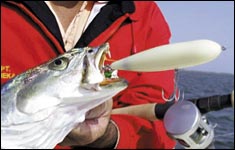
Scratching the surface with topwater plugs
is as addictive as it is productive.
By Larry Bozka
Remember the first strike you ever got on a topwater plug? I do.
And I wasn't even fishing at the time.
It was a black Arbogast Jitterbug, and I'd just thrown it at
a floating stock pond widgeon in yet another fruitless attempt
to snag and retrieve the downed bird when the bass quite unexpectedly
took center stage and forever changed the way I think about lure
fishing.
She smashed that plug like a dump truck hitting a brick wall.
All thoughts of waterfowl immediately evaporated. I went from
the hunting mode to the fishing mode in about two seconds flat,
seriously startled by what had just happened and determined to
make it happen again. Time and again, my jellied knees still doing
the Elvis wobble, I thrashed the surface with that bait. The Jitterbug's
concave metal mouth chugged loudly as I brought it back fast-way
too fast, in fact, to interest any nearby largemouth.

A prototype of the heir apparent to Texas' topwater anthology: A new walk-the-dog topwater member of Berkley's Frenzy hardbait
family tenatively dubbed the "Z-Walker." Slated for
release this month, this lure boasts two of a mullet-imitating
topwater's most critical attributes-it contains a noise-making
rattle, and is extremely easy to "walk."
|
A moment like that is fishing's own version of Buck Fever 101.
It teaches you a lesson, but despite your best efforts, you don't
always remember what you learned. If angling history indeed repeats
itself, that three-decade-old episode is as good an example as
any. I remember it, at the time, being one of the most exciting
moments I'd ever experienced as a fisherman.
It still is.
I'm reminded of that fact every time I watch an aggravated speckled
trout ignite on a topwater plug only to disappear in a foamy,
rippling circle of saltwater. This happens so often, by the way,
that there's actually a term for the experience.
We call it a "blow-up."
The big ones that get away
Usually, blow-ups tend to outnumber hook-ups. But if I'm going
to lose a fish, I'd much rather do it on a topwater lure than
anything else.
I also remember the duck-turned-bass incident of fall 1969 because
I totally lost it after the unanticipated surface attack and let
adrenaline overflow work the lure instead of common sense and
experience-not to imply that at the age of 13 I possessed much
of either.
Herein lies one of those invaluable angling lessons learned the
hard way, but not always remembered and acted upon. To this day,
following a crushing topwater strike I still sometimes lose it.
The most elemental of fishing basics-maintaining a productive
retrieve pattern, say, or avoiding excitement-induced backlashes-somehow
turn to mush.
But at least I have a good excuse.
Topwater fishing messes with your head.
Which is exactly why so many Texas saltwater fishermen are nuts
about tossing surface plugs. It gets in your blood, and it stays
there for good.
A brief history
Surface-scratching didn't gain serious notoriety along the Texas
Coast until the late 1980s. About a half-dozen guide buddies of
mine claimed to be the first to throw the Rebel Jumpin' Minnow
at Galveston Bay trout and reds. *Everyone* was suddenly a topwater
lure aficionado. The trend kicked off with a universal Big Bang
and continues to expand to this day.
The Super Spook-based on the wooden Zaragossa Spook introduced
to the market by James Heddon and Sons in 1922 (the plastic version
debuted in 1939)-followed closely in the wake of the Jumpin' Minnow.
Then came the Producer Ghost, a less costly knock off of the Spook,
along with the Storm Chug Bug and Big Bug.
MirrOlures had been a Texas saltwater standard for years, and
still are. But the introduction of the Top Dog in '98-followed
by the Top Dog Jr. in '99-put Florida-based L&S Bait. Co.
on the Texas topwater map for good.
There have been, and will be, other productive topwater plugs.
Many of the aforementioned baits initially came out as freshwater
lures but were then modified with saltwater hardware and color
patterns when the demand arrived. And it did arrive. Along with
coastal fly fishing, topwater lure fishing is one of the fastest-growing
segments of the saltwater scene. That isn't likely to change anytime
soon, as more and more anglers discover the technique and return
to the dock babbling endlessly about monster blow-ups from huge
and unseen predators.
Exceptions to the rules
Better than 10 years of topwater-targeted observation, in-depth
interviews with leading pros and industry experts and aggressive
field research has yielded some surprising information. I learned
a lot while putting together "Saltwater Strategies,"
and the new book title I'm currently woºrking on about saltwater
lures is likewise proving to be an exercise in continuing education.
To this day, every time I step out of the boat with a wade belt
box full of surface plugs I learn something.
That's just one of the many wonderful things about this sport.
Turns out the old stereotypes that formerly applied to "topwater
fishing" don't always apply when the topwatered water is
of the salty variety. Sure, there are reliable, even proven, generalities.
But it pays to keep an open mind regarding most accepted notions.
Foremost, it has generally been assumed that topwaters are shallow-water-specific
baits. Surface plugs have always been, and still are, prime for
presentation to gamefish in calf-deep flats. But if you're skipping
surface baits in deep-water climes, you're missing out.
continued
page 1 / page 2
| 




